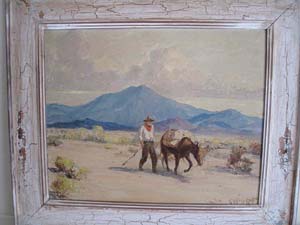
Bet we all hold favorite memories of a job that shaped our future in our early 20s. Mine involves working for Andrea, a scatterbrained but completely confident “older” (the 32) woman in Dallas at her start-up business, Decorators Anonymous. As a designer she realized that after she staged a house for sale, the furniture and art must go. Many large and important estates were bought and sold in Dallas at that time because of fluctuations in the oil market. So Andrea leased a big warehouse. Without any knowledge of business, or antiques, she commenced to do a booming resale business.
I became the resident antique expert, although I possessed little knowledge beyond running farm auctions in Illinois, where I grew up. But my employment with Andrea remains my most memorable job. I made next to nothing but learned the ropes. In the artist profession they say your teachers are as important as where and what you eventually sell. This story shows that.
A Geoffrey Holt painting
Rich and Lindsey sent me a Geoffrey Holt painting, an oil on board of a gold miner in a western scene. Lindsey found the painting in her grandmother’s attic. It turns out her grandmother’s family, the Sawyers, came to Santa Barbara in the 1880s. Lindsey’s grandmother practiced the then-popular womanly art of porcelain decorations with painted enamels. There’s truth in the saying in my business that artists collect other good artists, so I usually find good paintings in painters’ houses. Therefore, I suspected Rich and Lindsey had a good painting.
Painters must learn composition, proportion and color from somewhere, and I guess Geoffrey Holt owed this to a teacher named John. John Scott Bradstreet was the best in his day. For 40 years he operated a shop called the Minneapolis Craftshouse, first opened in 1904. The shop became a haven for handworks, a museum of the best in decorative arts and, unthinkable for its day, a place where people and styles of art and furniture mixed and mingled. Remember that in 1904 Minneapolis, at the end of the overblown style called Victorian. John brought Craftsman aesthetics to the upper Midwest. Geoffrey cut his artistic teeth there, as one of John’s many artist employees.
Bradstreet believed the American artist an heir to every style that came before and that blind adherence to any school of design or art, such as the French taste, was un-American. Based on the Craftsman Guild philosophy, developed by William Morris (1834-1896), a writer and book designer, in England, John created a show house like Morris had. The Minneapolis Craftshouse became a huge estate in the city with manicured gardens. Geoffrey Holt was one of 80 artists employed to furnish the home and gardens — all for sale.
More About This Painter
Geoffrey Holt, born in England in 1882, lived in Minneapolis in his young manhood, working for close to 20 years as an interior designer for John S. Bradstreet and Co. Here’s where this resonated with my favorite job, as I described above. The man behind John S. Bradstreet and Co. was also a tastemaker and artistic trailblazer. Geoffrey must have had the same memories of John as I do of Andrea. To give an example of Bradstreet’s designs that shook the world and still live: If you ever owned a driftwood coffee table, you owned a Bradstreet idea.
Now to Rich and Lindsey’s Geoffrey Holt painting. After working for John S. Bradstreet and Co., Geoffrey moved to San Francisco in 1921, then to Long Beach in the 1930s. He painted in the California plein-air style but may not have been very prolific. My research turns up only 25 canvases sold to date at auction. Two of his California Mission paintings, circa 1910, are in the collection of the California Pioneers, and a Grand Canyon landscape is in the Santa Fe Railway Collection.
A similar painting to Rich and Lindsey’s sold for $1,700. The highest price paid for a painting by Holt was $4,000, a eucalyptus-strewn landscape, so beloved of collectors of California plein-air.